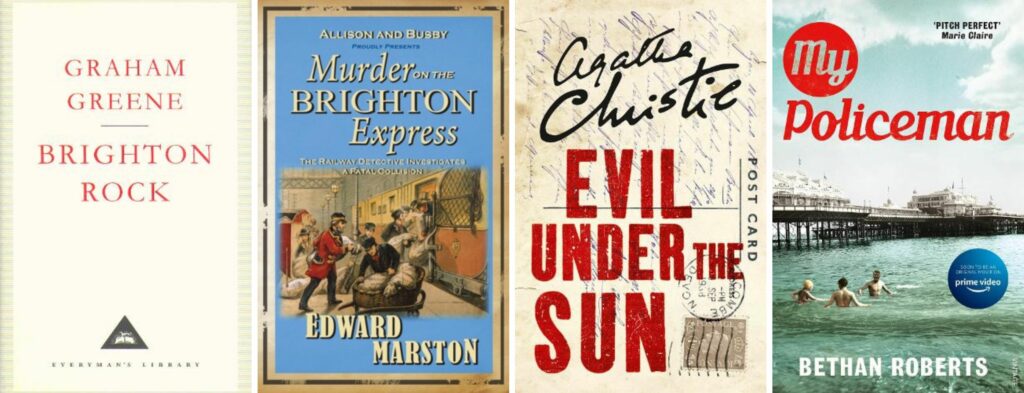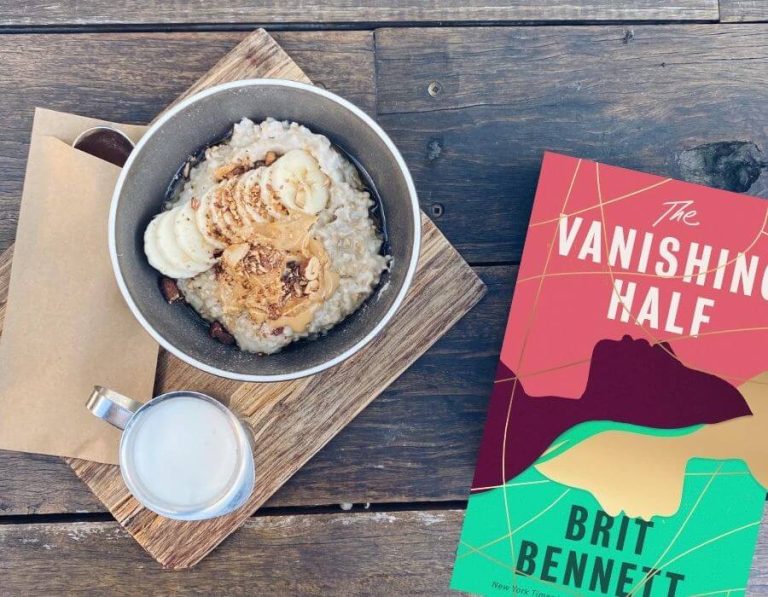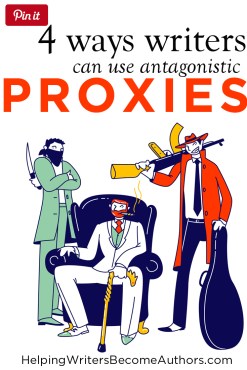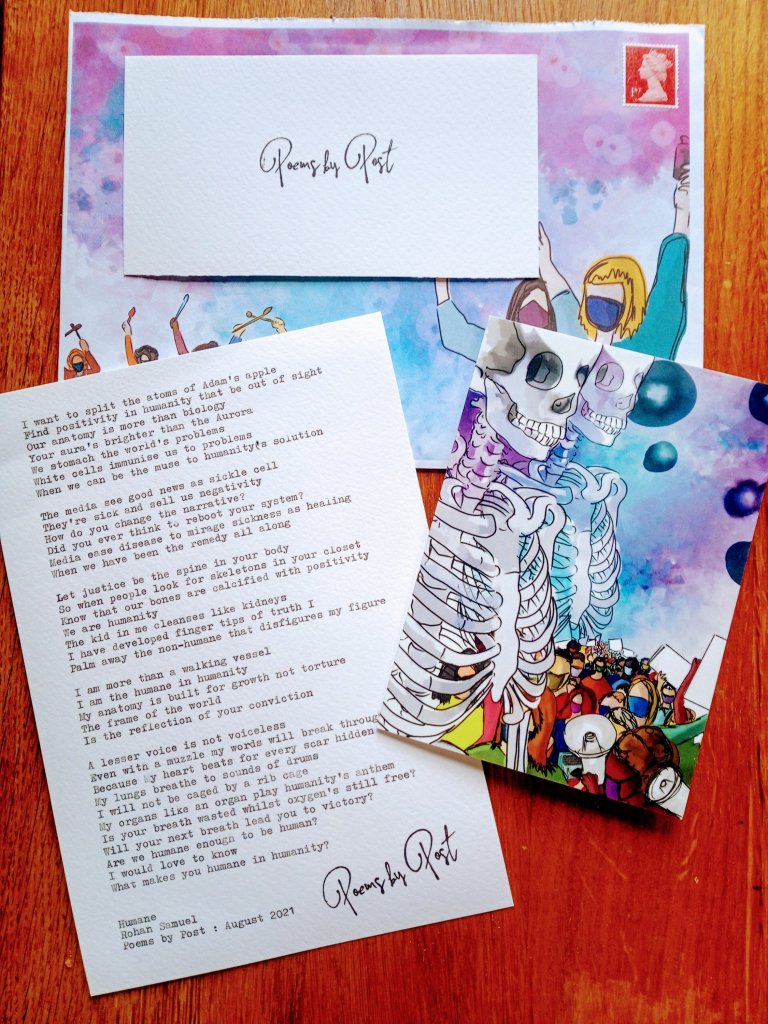The possessive title of this book echoes its narrative, where we get both Marion and Patrick’s sides of the story, but never hear the titular policeman in his own words. This novel is heart-breaking for all the characters involved. Whether that is Marion, who is truly in love with her policeman and unaware that she is being used as cover for a secret relationship, or whether that’s the two male characters living in constant fear of discovery.
The tenuous link here is Donald Leigh, a fictional author whose original story “Death Treads the Boards” is stolen by a second fictional author, Alan Conway. That story, a short mystery included in the book, is set at a theatre in Brighton!
Like a theatre, these places of entertainment become even more fascinating when you take a peek behind the scenery. Where the dust gathers and the cracks begin to show, that’s where you get to see the real history of a place.
Suffice it to say that I’m not the only writer to be inspired by Brighton. Here are some other excellent books that I’ve read that have a link to the seaside town.
It would be a crime to write a list of murder mystery books and not include Agatha Christie, so this one is a special mention.
Brighton Rock by Graham Greene
I find seaside towns fascinating, especially outside the height of the season. There is something incredibly theatrical about them. Freshly painted and tidied for the first slew of visitors that will arrive at the start of the summer. There are a new set of cast members, employed as shop assistants and hospitality staff. Then, when the audience of tourists leave and the show is over, that’s when things start to get really interesting.
Peter James is no stranger to writing books set in Brighton. This book, in the Roy Grace series alone, is his 18th.
As a lover of theatres, having worked in them for my entire professional career, as soon as I discovered this “lost” location, serendipity seemed to kick in. Everything else fell into place: the story, the characters, who the murderer was. What a boon! All I had to do was write it down and give it a title: Death on the Pier.
My Policeman by Bethan Roberts

While it is not set in Brighton, it is set on the Devon coast, so it is at least seaside themed. The glitzy Hollywood adaptation of this book relocates the action to sunny Majorca and in another theatrical nod in my direction, two of the characters are reinvented as theatre producers. The David Suchet version from 2001 is also worth a watch, being filmed at the hotel that inspired both this novel and “And Then There Were None”.
This one has a tenuous connection to Brighton, I have to admit. Anthony seems to be a master finding a new angle on the murder mystery genre. Whether it’s his outings as a character himself in the Hawthorne series, or this book within a book series, led by editor Susan Ryeland.
Peter James provides another theatrical link, as his books are regularly adapted in to plays that tour the UK. The eighth of these adaptations, this time of his book “Wish You Were Dead”, is set to hit the road in 2023. It goes without saying that it will be playing a week at Brighton’s Theatre Royal.
Of course, the film adaptation which promises Harry Styles in a policeman’s uniform is sure to sell a few bags of popcorn.
Murder on the Brighton Express by Edward Marston
For me, this book is classic Christie. The luxury summer hotel, a closed-circle setting, and a solution that is both ingenious and daring.
There are plenty of nods to Christie in my own book. A wind machine that is used for sound effects, and identical to the one described in my book, is used on the real-life production of “The Mousetrap” (which starred the aforementioned Attenborough and his wife, Shelia Sim). Also, the stage set for my play within a book seems to have been inspired by the one for her play “Spider’s Web”, which opened at The Savoy Theatre in 1954.
If anything, attitudes towards gay people were a little more lax in the era of my book – the 1930s. While the Criminal Law Amendment Act 1885 (used to send Oscar Wilde to prison) punished gross indecency with other men, it was considered a “sin” that any man could commit. There was very little awareness that there were men who were inclined to form romantic relationships with other men.
Picture You Dead by Peter James
Unsurprisingly, as someone who takes an interest in theatres and their architecture, it’s the architecture and engineering of the railways that appeal most to me. Edward Marston’s fifth outing of his “Railway Detective” contains his usual attention to historical detail as he describes Brighton, its station, and The Royal Pavilion.
I’d like to say that I included these details as Easter eggs for the incredibly attentive Christie fan, but both appear to have crept in entirely subconsciously. I suppose that’s emblematic of the influence that Agatha Christie still holds over all of us.
Railways, Brighton, and murder? You can see why I’m interested in this one.
Magpie Murders by Anthony Horowitz
I read Graham Greene’s iconic Brighton-set novel while writing my own, as it was set in a similar time period – albeit with a much darker tone. The film was also a great resource, with several parts of it set on The Palace Pier and containing tantalising glimpses of the theatre every now and then.
Social media star Francis Bourgeois is making train-spotting cool again. I’m afraid to say that I’m not particularly interested in the nuances between different types of locomotives, although I share the same boyhood fascination that many have with steam engines.
Jamie West worked on countless shows in London’s West End before turning his hand to novel writing. His debut murder mystery, Death on the Pier, recreates the Palace Pier Theatre as its setting, and his experience of working backstage on productions in London’s West End lends the book its authenticity as we meet murder mystery playwright Bertie Carroll, who turns real life detective when an actress is murdered, onstage, during a performance of one of his plays. Follow Jamie on Instagram here, and Twitter here.
As I began my research into Brighton’s Palace Pier, I very quickly discovered that there was once a theatre on the end of it. Not just any theatre – it was described shortly before it was demolished as the finest surviving theatre at the end of a pier in the country. Even its disappearance from the pier in the 1980s – prior to a planned restoration – was steeped in mystery. As a Grade II listed building, it should have been safe and still standing to this day. But unlike many of Britain’s “lost” theatres, which have either been demolished or repurposed, this one appears to live up to its “lost” moniker by simply being mislaid by its owners.
Evil Under the Sun by Agatha Christie
Magpie Murders is the first in the Susan Ryeland series. In it, the author whom she edits is accused of stealing someone else’s work and incorporating it in his own manuscript.
The film also has theatrical roots, with Richard Attenborough and many of the cast reprising their roles after appearing in a West End adaptation of the book a few years earlier. Attenborough returned to film in Brighton over twenty years later, this time in the director’s chair, for his directorial debut “Oh What A Lovely War” which used the interiors of The Palace Pier Theatre – another bonus for my own research.
I did say it was tenuous, but I’m yet to find an Anthony Horowitz mystery that I haven’t whizzed through.
In this latest outing, crime meets “Fake or Fortune” in a gripping story of murder and art. After picking up a painting for £20 at a car boot sale, it turns out that there is another hiding under the surface that could be worth a hell of a lot more. However, the dream of selling a rediscovered masterpiece for millions soon turns into a nightmare.

About the author
It was in the years following the Second World War, reaching a peak in the 1961, when prosecutions for homosexual acts increased. Police tactics of the time generated genuine fear and it is this period that forms the background for My Policeman.
Feeling inspired? Shop the best books set in Brighton below…







